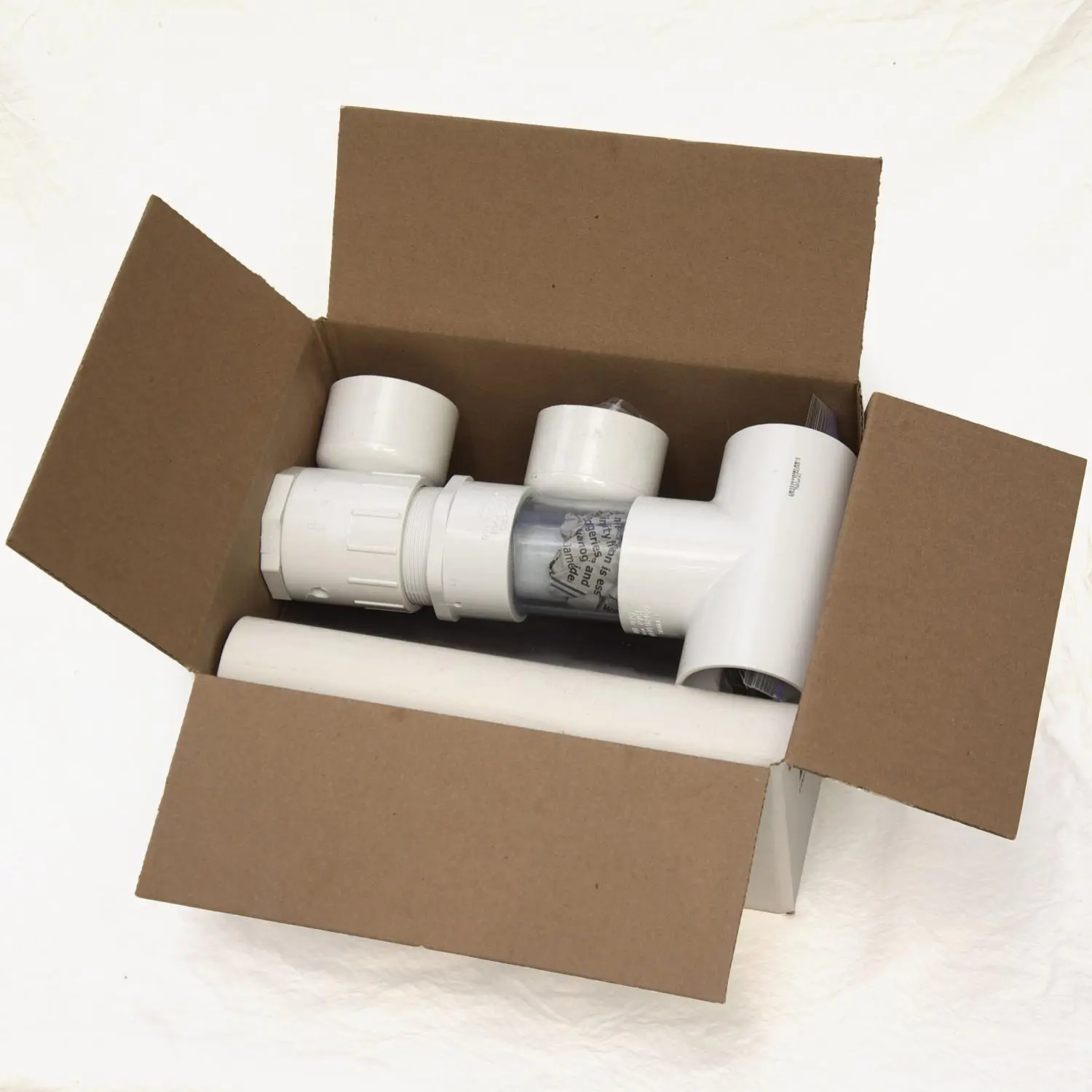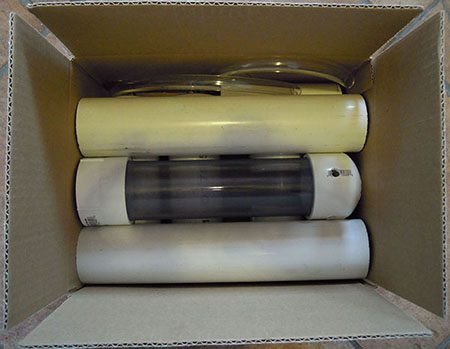Description
- Practical ‘table-top’ design.
- Easy to set up and use.
- Simple 40+ series-cell design.
- Significantly more efficient
~ than traditional electrolyzers. - Produces Brown’s Gas
~ for experimental purposes. - Compatible with all worldwide power standards
~ from 100 to 270 VAC and 35 to 65Hz. - Produces 50 litres per hour at 120 VAC and 60Hz using 2 capacitors.
~120 VAC BG production can be increased to 100 L/Hr by doubling capacitance.
~ we tell you where to order extra capacitors if you want them. - Produces up to 100 liters per hour
at 120 VAC and 60Hz using 4 capacitors. - Produces up to 100 liters per hour
at 240 VAC and 50Hz using 2 capacitors.
This kit includes the ‘special’ parts needed to set up this small, high quality, experimental electrolyzer that will exceed the efficiency of ANY known commercial electrolyzer (except ours, of course :))
Commonly available (or optional) parts like the timer switch, float switch, wires, terminal ends and supplies like glue and lye (the electrolyte), are not included.
The ‘extra’ components shouldn’t cost more than $60.
You need to know how to wire a light circuit to have the skill level required for the electrical assembly and simple construction skills (and tools) to cut the plastic tubing and build the stand.
Comprehensive, up to date instructions are in the ER50 online Resources, which you get access to immediately after purchase of an ER50 Kit.
NO transformer needed: This electrolyzer uses Capacitive Amperage Limiting (CAL) power supply technology, as detailed in our Brown’s Gas Books (2 capacitors are included in box) to achieve its super-efficiency. For more gas (BG) production, use more capacitors ~ the ER50 Resources tells you where you can order extra capacitors at surplus prices.
The gas Pressure Relief Tubes (PRTs) Upgrade ($50 value) is now included at no additional charge. These are the transparent side tubes. This is a SIGNIFICANT efficiency upgrade as it helps increase gas production without increasing electrical input.
Access privileges to Eagle-Research’s ER50 Resources is automatic (no extra charge) with the purchase of this ER50 Electrolyzer kit.
If you wish to purchase the ER50 Resources WITHOUT first buying the ER50
(because it isn’t available and you are building your own…)
You can purchase the ER50 Resources HERE
ER50 Resources includes upgrades, assembly instructions and application details that you need to understand, optimize, build and use your ER50… You will also need the Brown’s Gas Book 2 to understand the physical and electrical .design parameters
The tubes and tower are no longer Transparent PVC. To see the liquid level, just use the transparent side tubes (PRTs).
Transparent PVC is GREAT to see the Brown’s Gas (and ExW) being produced but the clear plastic has a really low softening temperature, exhudes oils into the electrolyte (which causes foaming) and gradually clouds (becomes translucent) anyway.
So all new kits will have white PVC only.
The ER50 is designed to last for decades. The biggest killer of the ER50 is people running them too long without cooling. The ER50 is not designed to exceed 37°C. If it gets too hot, the plastic will deform enough so that the fittings will start to leak. The duty cycle at 50 lph is about 20 minutes with a 3 hour cool down. The duty cycle can be extended if 3 of 4″ computer cooling fans are added to prevent the plastic from exceeding 37°C.
The Electrical Efficiency Upgrade option is described in the ER50 Resources. There are several ways to increase the wattage effciency of the ER50. We don’t do it in the ‘standard’ version because (frankly) it’s more costly… But if you want maximum efficiency (which can go over 100% Faraday efficiency) we tell you how to do it.
The WaterTorch Upgrade option is described in the ER50 Resources. The ER50 was originally designed to be a tabletop electrolyzer to provide a superior fuel-gas to mini-torches. Handymen, Jewelers and Artists LOVE this gas once they try it, as it does a MUCH better job than traditional bottles gasses like acetylene.
The Float Switch Upgrade option is described in the ER50 Resources. Float switch (automatic low water shutoff) is added when upgrading to the Agriculture application of the ER50, because the ER50 will be operating for hours unattended and low water level would kill the machine.
| Eagle-Research Assembled Chamber | Customer-Finished, Fully Operational |
SKU# ER1-K1-0004 • kit • 6″H x 12″L x 9″W • 6.6137lb / 3000gm
Further DIY self assembly tips:
ER50 Assembly and Operation Manual identifies all the parts of the Basic ER50 Kit and shows how they go together.
https://eagle-research.com/wp-content/uploads/2019/06/21_ER50OpManV170124.pdf
Here is the Normal ER50 Kit online assembly video
https://www.youtube.com/watch?v=obpBHOfjrBA&t=1690s
Here is the assembled version / cost
https://eagle-research.com/product/er50-fully-assembled/
Here is how to assemble the agriculture version of
https://www.youtube.com/watch?v=Rm4qFFGuWxs&t=13s
but it is additional cost for parts and labor. By the time you add all the ‘extras’ to equal the AquaCure, you might as well buy an AquaCure. The refurbished AquaCure model AC50 is only $1800 USD.
https://eagle-research.com/product/aquacure-model-ea-h160/
ER50 terminal plate tips:
We silver solder the #10 by 3/4″ (10×24 threads) stainless steel pan and slotted head bolt onto the terminal plate.
Install O-ring and hot glue on terminal plate bolt threads. The O-ring is Buna-N with 1/8” in rubber diameter with a 1/8” center hole. The hot glue goes in an 1/8” ring on the threads above the O-ring (So it will go into the threads of the cap and seal them).
install terminal plates into the cap so that the bolt ‘just’ extends past the outside of the cap. Then heat the terminal plate with a hot air blower (hair dryer works) until you feel the heat on the bolt end outside the cap (takes about 40 seconds). At that point the hot glue is melted and will flow into the threads as you tighten down the terminal plate… BUT FIRST only screw in the terminal plate far enough to put a 10×24 nut on the bolt; holding the bolt (with a box end wrench) tight against the plastic will prevent the plastic threads from stripping out as you finally tighten the terminal plate against the inner side of the plastic cap. The edges of the plate should ‘indent’ a bit into the plastic. At this point you have a ‘double’ seal; the glue in the threads and the o-ring compressed between the plastic of the endcap and the steel of the terminal plate.
To tighten and re-seal, with the terminal plates installed, you can try to heat them and (using a nut against the plastic) turn the terminal bolt (I’d use two nuts locked together to allow a wrench to be applied) to re-tighten (squeeze) the o-ring seal… Then after all that cools, clean up the end of the cap and apply an epoxy (like JB Weld) around the terminal bolt and seal using a stainless steel washer. Put the terminal end on the bolt and apply more epoxy.
As long as the ER50 (or HyZor) doesn’t overheat, that should seal it.





Reviews
There are no reviews yet.